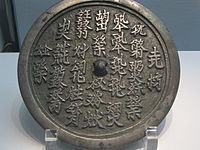Khitan small script
| Khitan small script |
|
|---|---|

Bronze mirror with a poetic inscription
|
|
| Type | |
| Languages | Khitan language |
|
Parent systems
|
Oracle Bone Script
|
|
Sister systems
|
Simplified Chinese, Kanji, Hanja, Chữ Nôm, Zhuyin |
| Direction | Top-to-bottom |
| ISO 15924 | Kits, 288 |
The Khitan small script was one of two Khitan writing systems used for the now-extinct Khitan language. It was used during the 10th–12th century by the Khitan people, who had created the Liao Empire in north-eastern China. In addition to the small script, the Khitans simultaneously also used a functionally independent writing system known as the Khitan large script. Both Khitan scripts continued to be in use to some extent by the Jurchens for several decades after the fall of the Liao Dynasty, until the Jurchens fully switched to a script of their own. Examples of the scripts appeared most often on epitaphs and monuments, although other fragments sometimes surface.
The Khitan small script was invented in about 924 or 925 CE by a scholar named Yelü Diela. He drew his inspiration from “the Uyghur language and script,” which he was shown by a visiting Uyghur ambassador at the Khitan court. For this reason, Khitan small script was originally thought to be a daughter script of the Old Uyghur alphabet.
Using a smaller number of symbols than large script, small script was less complex, yet still “able to record any word.” While small-script inscriptions employed some logograms as well, most words in small script were made using a blocked system reminiscent of the later Hangul writing of Korea, meaning that a word is represented by one group (square block) composed of several glyphs with individual phonetic meanings (somewhat similar to the jamo units of Hangul). Unlike Hangul's jamo, a Khitan phonetic symbol could represent not just a single vowel or consonant, but a CV or VC pair as well. Each block could incorporate two to seven such "phonetic element" characters, written in pairs within the block, with the first half of the pair on the left. If there were an odd number of characters in a block, the unpaired character would be centered below the preceding pair.
...
Wikipedia
